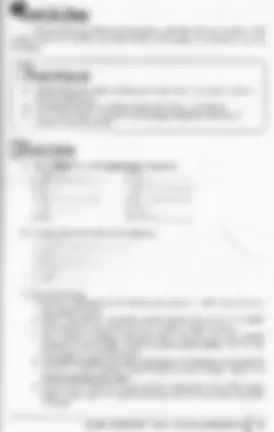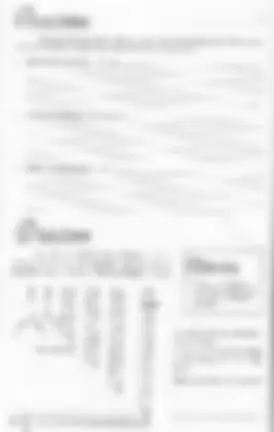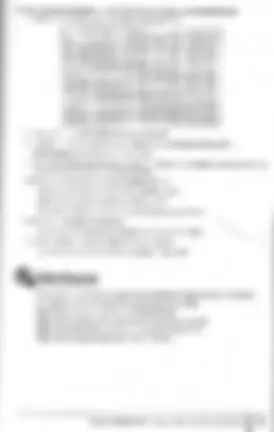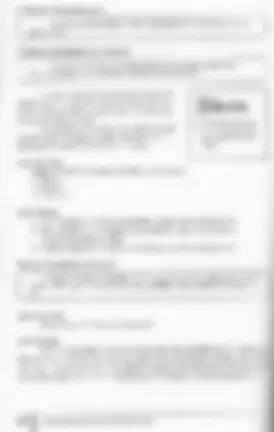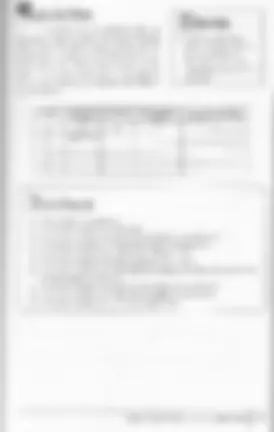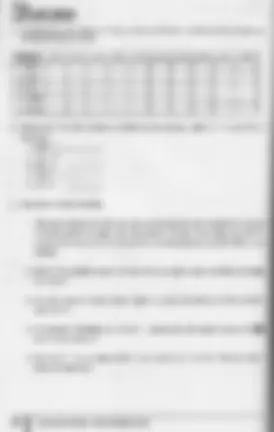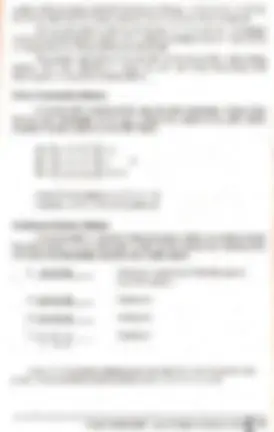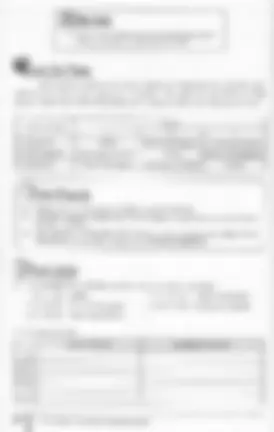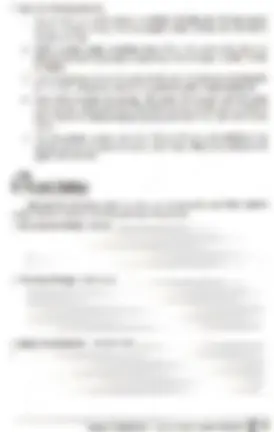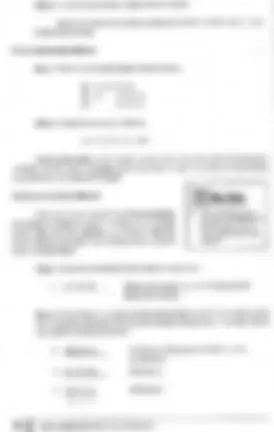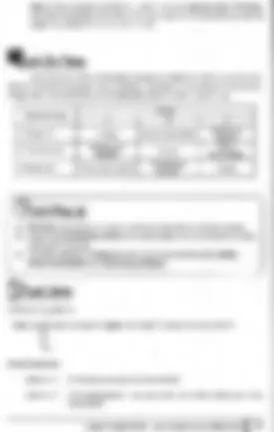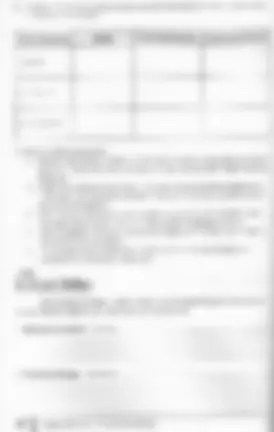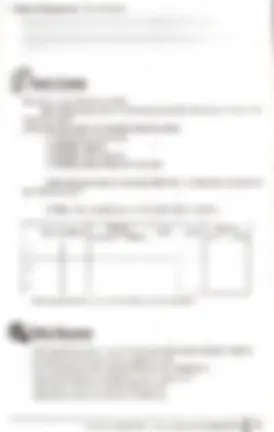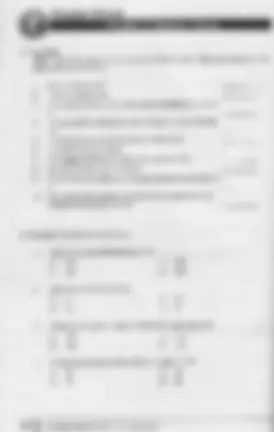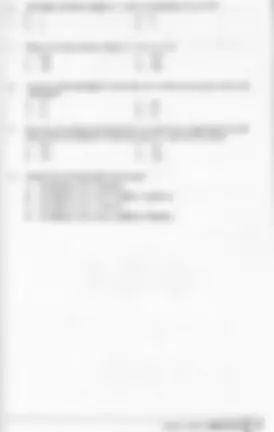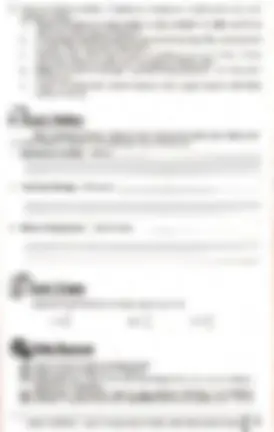Download number theory for math and more Exercises Ethology in PDF only on Docsity!
Ghapter 2: Number Theory
ussol 1
Prime and
Composite
Numbers
'V.tl!:g!-qPg!gr
Samuel wrles the following numbers on a piece ot paper: 48,57,37,91 and
- He lhen (^) asks Oave to denliry rhe number which does not (^) belong io the group
Dave qives^ lhe @neci answe. What is hts answer?
@ [et! Focus
What do you lhink is the basis of Oave in identify ng the numtilr whtch is
d tierpnr tom i-e resr? I el s co-side. sol e poss,bte wdys.
- All five numbeG nave two digits so il cannot be used as basis.
- Two oi lhe numbers are even white three are (^) odd, so agatn, this ctassi,icalio; does not make any one number dttferenr.
How aborl tind ng all the faciors oi each number?
Al lhe end ofihe lesson, you should be abte lo:
. (^) differeniate prme (^) from composte nurnbers ([,,t4Ns]lb 66)l . (^) wrile a given number (^) as a prcdlct of ils prime f6clorc ([,!4NS-
llb-67);and
. (^) solve word problems involving pime (^) and composire numbers.
4A- 1,2,3 4,6 (^) 8,12, (^57) - 1, 3, 19, 57 37 1, 91 1,7 13, 76 1,2,4,19,38 76
6t lesson Outcomes
Observe ihai the number 37 has oniy ndo
faclorc, 1 and 37 (the number ilsell while each of ihe
resl has other lactors aside irom 1 and itsetf.
A number (^) s.a ed Pr,r?e if t has onty lwo facrols. Afew (^) examptes of prime
nrmbers are 2, 13, 29, and 83.
On the orher hand, numbers wth more than rwo factors arc ca|ed Composite.
For instance,4 1s,46, and 120 are composile.
Choprer 2, NUMlEliXrcrY Le$on t: t,tme ond conporireNumbdr
Try This:
. Tellwhslher each oflhe lollowing numberc is pnm€ or composite. ' (^12) 2.97 3138 4.51 5. 1 1. 2 is prime since it has only two^ faclors_^1 and^ 2. ln^ fact,^2 is^ the^ small€sl
p me number.
97 is prime. lt is th€ biggest two_digit pnme number'
138 is obviously composite since it is €ven. Each of ih€ even numb€rs^ grestar
than 2 has 2 as factor olher^ than'1^ and^ itselfwhich^ makes^ alleven^ numbers
greaisr than 2 as prime.
51 rs composrle wiih factoE of 1.^ 3.^ 17. and^ 51.
5. T is NEITHER pime^ nor composite^ because it^ has^1 lactor^ onlv.
Every composite number^ can^ be^ expressed^ as^ a^ product^ of^ its^ prime
faclors. This process^ is call€d p,ime^ factotization.^ Fot^ example'^ let us^ find^ the^ prime
faciorization of 24 usang the Faclor Tree^ wleihod-^ Lel^ us then express^ the^ answe'^ in
, A^^ Choose any pair oI^ facloB^ of 24. Aside Z--\ a-.-\
ftom 4 and 6. we may also use 2 and 12
2223
The prime^ fadonzaton d 24is 2,2 t^2 x^3 ot^ 2x^ I^ 3. To check^ if ihe^ prime
factorizaiion of a given numb€r is corect, we ask^ ou6elves^ two questions:
' (^) 1. Are all factors pnme already?
2. ls the poduct^ of lhe p^ me factors the same wilh^ lhe^ given^ numbe,
ln our given^ number, lhe pime^ factoE arc^2 and^ 3 which^ are bolh^ primss.
product of 2 i^ 2 x^2 r^ 3 is 24. Therefore, our prime factorizalion of 24 is correci.
Give the pnme factorization of^ 90-
90
2/-
9 choose^ any pair of^ factors.of^
go We mav also choose
Z'\ Z^ from2&a53&30,5&18,and6&15' 2533
The prime fadonzaion of 90 is 2 x^ 3'? t^ 5.
Lochlng ,l6th.mdnct^ h^ lh.^ llnM.dloi.^ G.ods
d
[ !(^ Let's Rerlccr
Afler l€arning this tesson, refl€ct on how it can be teamed by your futurc pup,ts
in a more effeciive, creativs, and meaningfut way. Oiscuss your:
- (^) Motlvatlonal AcUvlty. (^) I witt use
- Teaching Slrategy. I will (^) emptoy
- Mode of Assessment. I wirt
ll's (^) easy to check if lhe numbers (^) 2, 4, 7,
33 and 58 are prime or composile using lhe hetp of
divisibilily crile a. Howeier, with big numbels, it woutd
I
g
- E €E^ :e^ $€ .= (^) ie ii *i
^,
ttEE (^) *S Si ra\ (^) tL= st ,r
rhe pame (^) tao (^) E i^ g:- 2ii EN
I
. Multiples a.e p.oducts^ I
oltheo'vennumber:n.i I
rhe naiu,alor6!nhn. I
.umb€6 (^) i
, numbsr which are, fierefore,
e of lhe number we are iesting
€ 100). Since 11, = 121 and rking.
rmbers less than 100 using the
., Ieochlig (^) Mdh.mot6 li ln. (^) tnidnEdtqh G.d.;
(^1 2 3 6 8) I 10 (^11 12 13 14 15 16 17 18) '19 20 (^21 22 23 24 25 26 27) 2A 29 30 (^31 32 33 34 35 36 38 39 ) 4'1 (^42 45 46 47 48 49 ) 51 52 53 54 56 58 59 60
6l 62 63 65 66 67 68 69
8l a2^84 85 86 a7 88 89 90
91 92 93 94 95 c6 97 98 99
Prime numbers between I
1 Piace lhe numberc from
and 100 with the Sieve of Eratosthenes
1 io 100 in a iable like this
2 Cross out 1. rl is NETTHER p me nor composite
3. Encircle 2. ll ls ths smatlest pime. Htghtighl its muttiptes starting wirh 4.
All ihe highllghted numberc arc composite.
4. Frcrn the numberc thai are lefl, encircte 3. Hightight ils mutiiptes stading with 6. An
easy way lo do ii is by counting in ihrees.
5 Encircle 5. Highlighi (^) its mr tiptes stading with.
Why danl we need to took ror the multiptes ot 4?
What do you observe with lhe nultiples of 5?
Arc there nulliples ot 6 that are nat hightightect yet? Why?
6. Encircle 7. Hishiqhl is mulliples.
Do we have ta look far the nultiples ot 8, 9 and tO? Why?
- Finally, encircle 11 and highllght its other muttiptes.
So what are the prine^ nunberc bet een 1 and 100?
@.onih. Rrror*,Y.-
https/www.khanacademy.olg/maih/pre-a]gebrc/pre-algebra{acrors-muttiples/ pre-algebla pime-numbers/v/.ecognizing-prime-,rumbels https://www.youtube.com/'/vatch?v=3h4UK62Qrbo
https://www.maihgood es.com/tessons/vol3/p me composite
htlps://M.malhsisf un.com/pime-composite-numberhlmt
hllps://www.youtube.com/waich?v=Rc_2IttcOPS
c\dprs2 nueiEllriEoiY !.so. r.tnmeond compor[e Nuhber
A I€st for Oivisibillty by 2
. Anumber^ is dNlsrble^ by^2 ir iseven^ I
A Test tor Dlvisibility by 4, 8, 16 and Other Powers of 2
Let , be a nalural number Then (^4) divides /? if, and onty if, 4 dtvides lhe number named by the lasl lwo digiis of r. (^) Similarty, I divides , if, and onty if, 8 divides the number named bythe lasl three diqits (^) ofr. ln generat, (^) 2, divides , il
and only il2,divides lhe number named by the tast /digits of r_
Lets Try This:
Answer lhe following with True or Fatse.
1. 231 is divisible by 2
2. 2 372 is divisible by 4
3. 27 576 is divisible by 8
4. 135 792 is divisible by 16
Let's Ch.ck:
- 231 is NOT divisible by 2 because il is ODD_ When divided by 2, ii wil g ve
is 5792 is divisibl€ by 16.
A Test ror Divlsibility by 3 and 9
2 372 is divisible by 4 or 2, - exponent is 2 so we take ihe tasr 2 digits of
2 372 which is 72 and is divisible by 4- 27 576 is divisible by 8 or 23 (exponent is 3)- since the last three digiis 576 is visible by 8. 135 792 is divisible by 16 or 24 because the last four digirs of 135 792 which
A naiural number is divisible by 3 if, and onty if, the sum ot irs digits is
divisible by 3. Similady, a naluralnumber is divisibl€ by 9 if, and only if, the sum of
ils digils is divisible by 9.
Let's Try This:
ls 423 divisible by 3?
Lel's Check:
To find out, we add 4 + 2 +
423 is divisibl€ by 3. Similady, 423
which is 9, is divlsible by (^) 9.
A Test for Divisibility by l
3i the answer is (^) 9. Sinc€ I is divisible by 3, ihen
is also divisible by 9 sinc€, obviously, the sum,
Let, bea natu€lnumber. Then, isdivisibte by 10 jf, and onty if, iis unir
digit is (^) 0.
chopf 2: NUr !fi IltEotY le$on 2: oMn ry Rubr
A Test Ior Divisibility by 5
Lei , be a nalural number. Thenr) is dlvisible by 5 if, and only ii, its
digit is 0 or 5. 'rnit
To state the Divisibility by Producls Theorcm^ rn
another way: ll a number is divislble by both of^ its^ hvo
tuctols which are relalively^ pnme, then it is^ d^ visible by
the prcduct of these faclors.
For example, ihe nLrmber 72 is divisible by bolh
3 and^8 iwhich ars relalively^ pnme), thereiore,^72 s
divisible by 24 which is lhe prcduci^ oi 3 and 8.
Let's Try This:
Explain why the,irst number is divisibie by ihe second.
1. 216t 6
3. 1 320i 15
L.t's Check:
A Test for Oivisibility by Productg
Lel a and D be natuEl^ numbers with^ no^ common factor other than^ 1.
Then. ifa divdes c and b divides c, itiollows that ab divides c.
I
iEH.reE i |. rwo numoeeare said! I b^ be^ erar,ery^ p^ me^ I I lhen @mmon^ lador^ rs^ t | 1only.^ I tl
1. 216 is divisible by 0 since it is divisible by boih 2 and 3 (faclors of 6).
2. 504 is divisibe by 12 because it is divisible by 3 and 4, two faclors of
12 which are rclalively prime.
- I 320 is divisible by 15 since I is divisible by 3 and 5 (faciors^ of 15).
Test for Divlsibility Test by 1l
A natuml number is divisible by 11 lf, and only il^ the^ difierence^ of^ the
sums ol the digits in the^ even^ and odd^ positions^ in^ lhe^ number^ is divisible^ by
11
Let s Try This:
Lel's find out if 4'l 019 is divisible by^ 1'1.
Let's Check:
ln 41 019, lhe digits in the odd positiofl (firsl, thnd, and^ itth)^ are 4, 0,^ and^ I^ and
th€ir sum is 13. on the olher hand, the digits in^ ihe^ even position^ (second^ and^ fou,tt)
are 1 and 1 and their sum ls 2. The^ difiercnce between ihe sums of lhe odd_placed and
even-placed diqits, (^13 2) = 11,^ is divisible^ by 11.Ihercfore,^41 0'19^ is divisible by^ 11.
A. Complele the rable. write (r') if rhe number on the lefl is divisible by the numb€r on
lhe lop and wdle (x) if nol.
2 3 4 5 6 8 9 't0^11
B. Datemine if ths frrst number is divisibls by lhe second. Wrile D if it is and ND if
- 5296 i 3
- 10052 | 2 (^) _
- 976;4 _
C. Solve th€ followins probl€ms.
1- 156 pupils will go to a f6ld lrip and severalte6chels are assignod to a group
of equal numbsr of pupils.^ The head tsacher lhought of grouping^ th6 pupils^ in
groups of 3s, 4s, 5s, 6s, 7s, 8s and 9s. Ar€ all groupings possible? Show your
2- Find alllhe possibl€ values ofA and B if the 6-digit numb€r 2A1686 is divisible
by 4 and 9.
3. Find the smallest 4{igit numb€r which is €xactly divisible by all lh6 numbers
fmm 2 to 10.
4, lf a number is divisible by 3, 5 and 11, what as the noxt larger number diu&
bi sll t\ese numbers?
5. Who am l? 'l am a 2-digit number I am divisible by 3 and by 4. My tens digh is
twice my ones digil.'
4
Di{ 7. (^) !- [et's Reflea
Aft6r learning this lesson, reflect on how it can be.leamed by your^ future^ pupils
h a more effective, creative, and meaningful way. Discuss your:
- Motlvational Activity. I will use
- Teaching Strategy. lwill^ employ
- Mode of Assassment. I will administer
Let's make a generalization regarding Divisibility^ of^ Sums and^ Differences^ by
answering the following questions.
- Give two numbers and a third number which can exactly divide the first^ two numbers.
- What is the sum of the first two numbers? ls^ it^ divisible^ by^ the third^ number?
- What.is the difference of the first two numbers?^ ls^ it^ divisible^ by the^ third number?
Do the activity again using a different set of numbers. Does^ it still work?
Now make a generalization regarding divisibility of sums and^ differences.
@,amrn*-"" hft ps://www.mathsisf un.com/divisibility-rules.html https://www.khanacademy.org/math/pre-algebra/pre-algebra-factors-multiples/pre-
algebra-divisibility{ests/v/divisibility-testsjor-2-34-5-6-9- 1 0
https:i/www.mathwarehouse.com/arithmetic/numbers/divisibility-rules-and-tests.php https://www.youtube.com/watch?v=Yl pAKJ4rf:M
https://w.youtube.com/watch?v=i 1 6N01 ldlhk
Chqpter 2: NUMIER IHEORY lesson 2: Dlvlslblllty^ Rules
numbers that can exactly divide 48. The factors of 80 arc 1,2, 4, 5,8, 10, 16, 20, 40,
80. On the other hand, the factors of 96 are 1, 2, 3, 4, 6, 8, 12, 16, 24, 32, 48, 96.
The common factors (^) of 48, 80 and 96 are 1, 2, 4,8, and 16. The greatest
among the common factors, which is 16, is calLd the Greatest Comtnon Factor (GCF)
or Greatest Common Divisor (GCD) of 48, 80 and 96.
The process used above to find the GCF of 48, 80 and S is called Listing Method. Two other mothods in finding the GCF are Prime Factorization and
Decomposition or Continuous Division Method.
Prime Factorization Method
To flnd the GCF of 48, 80 and 96 using the prime factorization method, simply
find the prime factorization of the given numbers-the product of the prime factors
common to all given numbers is their GCF. That is,
2.1 48 80 96 Divide each number by 2. Write the quotient
below the numbers.
x x.
xix
Com,non Prim. Factors: 2 x^2 x^2 x^ 2 = 16
Therefore, the GGF of 48, 80 and 96 is 16.
'Continuous Divi3ion ilsthod
True to its name, in using the continuous division method, we continue dividing
the given numbers by a common prime^ number until the quotients are relatively prime.
Let's take a look the procacs using the same numbers above.
. 2 |^24 40 48.^ Divide by 2.
(^2) | 12 20 24 Divids by 2.
(^2) | 6 10 12 Divide by 2. 3 56
Since 3, 5, 6 are already relatively prime,^ then the GCF of 48, 80 and 96 is the
product (^) ofthe prime (^) faclors used as divisors which is 2 x 2x2x2ot 16.
Chopter2:NUT.IBERtHEOtY terlon3iGr{letlCo.monfocU,teCf)
|
ilBlblbq (^) i |.^ Two^ or^ moE^ numbers^ ae^ said^ lo^ be^ retattv.ty pdme^ f^ i I they^ have no more^ common diviso.s ex@pt^ 1.^ I
$t rpr"*
L€l's lind out if which of the lhree methods in finding the cCF you tike best.
Solve for the GCF of the given^ sel of numbers. The ctass witt be divided in lhree
groups. Please refer 10 the table below on the assigned method for each grolp to use.
Group (^1 2 ) '1.28 (^) and 70 Lisling
- 52 and 65 (^) Lisling
- 36 and 54 (^) Listing
UYleLlgELA o Factors are nun'beE beng multiplied to gel lhe producr. o Great*t Common Factor (cCF) is the biggest number that c€n exacity divide lhe given numbers.
. The (^) methods of rnding lhe GCF of lwo or morc (^) numbers are Lisling, Pdme
Faclorization, Continuous Division, and Euclidian Atgortthm_
E^ l-ZLet\t&a- Solve
A. Find lhe GCF of the following numbers using the merhod indicaled. 4.21, (^) 35, 84 (^) - Prime Faclo zalion
- 42, 72, 90 (^) - Conlinuols Division
- 12, 14,20 Lisling
- 24 and (^30) - Prime Facto (^) zalion
- 24, 32, 56 Continuous Division
B. Complele the table.
ffirr,"
Finding lhe GCF of Numbe6 using Euclidian algorithm.
The methods we learned in linding the GCF may be easy to use but only wih
small numbe6. lf^ given large^ numbe6, then^ it might require^ morc^ time^ and calculations
if we lisl^ all^ faciors^ or if^ we^ frnd^ lhe^ prime^ factorization^ of th€^ numbers..^ One^ method
lhat may be used with^ big numbers is^ lhe^ Euclidian^ Algorithm. Leara^ this^ method^ by
fo,'owng the^ sleps below.
Find ihe GCF of 240 and 288.
Step 'l^ : Divide the bigger number by lhe smaller lf^ there^ is^ no^ remainder,
then the divisor (smaller^ number) is the GCE ll^ ihere is a^ remainder,
proceed lo step 2.
Step 2: Divide lhe^ smalier number^ by^ the remainde..^ lf^ there is^ no^ remainde( lhen rhe divisor^ is lhe^ GcF.^ lf^ lhe.e^ is^ a^ remainder, repeat^ the process- What is your answer?
Do you think this method will slill work wilh three given numbers? Check it^ by
mak,nq yoL'^ own examples.
@q@sss,,*I
httpsr/www.mathsisfun.com/greatesl-common-faciorhtml
https/www.youlube.com/walch?v=uE908N5JYB
https://www.youlube.com/watch?v=Nikjbvb3zv
https:/l,!ww.puelemath.com/modules/lcm gclhtm
https:/,h/w;.khanacademy.org/math/pre-algebla/pre-algebrajaclors-multiples/pre'
algebra-greateslcommon-divisor/v/greatoslcommon-div sor
Ieo.hi.g Molh6molici ln the lnirmedlote orcdes
Ghapter 2: Number Theory
u$.r
I
Least Common
Multiple (LCM)
/61 Lesson Outcomes
At the end of lhe lesson, you should be able lol
. (^) frnd ihe multiples (^) ofa numb€r: . (^) rnd lhe common multipl€s and least common mulliple (LCM) oftwo or
more numbers Lrsing the following methods: lisling, prifte^ factorization,
and continuous dlvision (II4NS-|lc{8r1^ and 69.1);and
. (^) solve rsal-life problems involving LCM (^) of2-3 given numbers (MsNS- te-70-2)-
Vle$e!-qPercr
$,Vsu-Himamaylan Cily Campus has ihree bells. BellArings every 60 minules, Bell
B every 90 minutes, and BellC every 45 minules. They all ring together at 7:00 a.m. When
is rhe next rime (^) that they will all ring together again?
The most logical way lo solve the problem is by lisiing lhe time from 7:00 and
adding successively 60 minutes or t hourforBellA,90 minutesfor&118. and45 minutes
lor Bell C until lhe first common tims emerg€s. This, however, mighl lake loo lotrg to
do. The best oplion is to solve by finding lhe Least Common Multiple ot the numbers (in
minules) and converl them to hours, then add lo 7:00.
Let us frst deline "inulliple'. Whal is multiple orwhat are mulliples ofa number.)
Multipl€s are producls^ of ihe natural numbeB and ihe givsn number. For inslance,
he multiples of8 are 8, 16, 24,32,40, and so on. These sre derived by mullaplying 8 by
1,2,3,4,5, and so on.
Let us now solve lhe probl€m above using lhe Lislins [4ethod.
Lblins M€thod
Step 1: List the mulliples of each number
45 - 145,90, 135 180,
Choph{2:NUi iElniFOtY te$on 4: te6lCommo. Mu[ipl. (LCM)
Stop 3: The remaining numters 2, 1, and 1 are now relatively prime. Therefore,
lhe prime factorization of 60, 90-and 45 is the poduct of lhe prime divisors and lhe
remaining quotient 3 r 2 x 3 x 5 x 2 = 180.
9tstD,-u$.
L6t's tind oul if which of the three melhods in linding lhe LCM do you^ like b€st.
Solvs for lhe LCM of the'given set of numbers. The class will be divided in lhree groups.
Please reier to the lable below on the assigned melhod for each group to use.
6roup
1.28 and 70 Listing Division
- 24 and 12 Listing
3. 36 and 54 Conlinuous Division Listing
&fgilarq a ,{u][plea are products of a given nomber and lhe naturarcounting numbers. a L68t common Multiplo (Lcti,l) is t\s leasl numberlhal c€n exactly be divided by lhe given numb€rs.
. Th8 thr€€ mothods of fnding the LCM of 2 or more numbors ar€: Lldlng,
Primo Factorlzatlon and Conllnuou3 Dlvlslon.
Solve
A. Discovering pattems
Ta6k List lhe frsl 5 common multipl€s of6,8 and 10 using the Lisling Melhod.
6- 8- 't0-
GuldeQu$tiom:
Ouestion 1: What have you observed from ihe lisl?
Question 2: Whal generalizalion^ can you^ make oui of lhe pattem^ you^ have
dismvercd?
ciorhi 2: r{ uMlEt tnEorY r.*d4rerconmnMumele(tcM) (^) I 39
B. Find the LcM ofthefollowing numbers using^ theihree^ methods. Uiilize the given table
Encircle your final^ answsr
clven Numbsr3 UidnC^ Prlmo^ F.ctorlator^ coitinuouB^ Dlvblon
1- 4A,
3-2,4,6,A,10,
C. Solve ihe following^ problems
- Find the leasi number of sleps in a stairc€se that when a p€rson goes up 8 steps
al alime, 12 sieps at a time, org steps al a lims, therc are^ stillT^ steps remaining
- A lighlhouse flash€s ils light every I 2 minules. Another lighlhouse flashes every 18 minutes. lf the two lighthouses flash logether at 12:00 noon,^ at^ what time will
they nexl fash togethe,
- When the box of biscuits is shared equally among 12, 15, or^18 children, there are always 8 biscuits left. Find the smallesl number of biscuits^ in^ the box.
- I have 3 numbers. They are consecutive multiples of^ 3.^ lheir^ sum is 27. What^ is
the LcM of these 3 numb€rs
- Find lhe least number which when divided by 12, 15, 18, and 30 gives the
remainder6.9. 12,^ and 24, respectivelv.
t:( Let's^ Rcflcct
Afier learning lhis llsson, renact on ho* il csn b€^ l6am.d^ by^ vour lulure^ pupils in
a more eflsciive,^ creaiive,^ and^ meaninglulway.^ Discuss vour:
1. Molivatlonal Actlvity. I will use
2. Teachins Slratogy- I will employ
Iedchlng r^oh.hon t h he H.m.dloi. 6Ed.r

